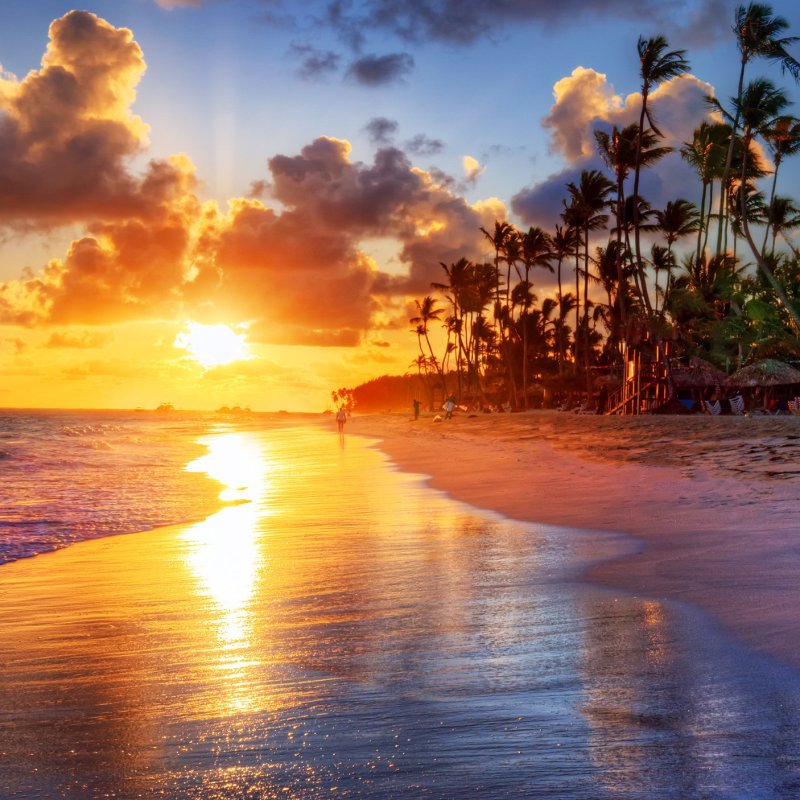
Note: The Travel Awaits team regularly updates content to provide the latest, and most accurate information to our readers. The updated content in this article may not reflect the views or opinions of the original author.
Videos by TravelAwaits
Sometimes, you’re just really ready for the beach! Whether you’re hoping to escape winter’s chill or just need some good old downtime, there’s nothing like a little sand and surf to soothe the soul.
But when it comes to picking a spot for that sun-kissed island vacation, there are many options to consider. Two of the most popular are Hawaii and the Caribbean. Both feature amazing beaches, terrific resorts, and the perfect setting in which to relax. But in our book, that’s where the similarities end. From cultural differences to price points to climate, here are a few key differences between the 50th state and places like the big island of Jamaica and Grand Cayman to help you determine which destination is right for you.

Hawaii vs Caribbean – 9 Biggest Differences To Consider Before You Visit
1. Time Spent In Transit
Depending on where you live, it can take longer to get to one destination than the other. Those who live in the Midwest can hop on an early-morning nonstop flight to the Caribbean and be barefoot on the beach — with drinks in hand — by noon. Meanwhile, getting to Hawaii often takes a full day, not counting those pesky connections with long waits. Of course, the opposite is true for those living on the West Coast.
Your travel time — and how much it chips away at your total vacation time — is certainly a factor worth considering when planning your big getaway.

2. Degree Of Jet Lag
If you’re the type whose circadian rhythm is easily thrown off, keep in mind that there are some pretty large time-zone differences to contend with when it comes to traveling to Hawaii. While most of the Caribbean observes Eastern Standard Time, Hawaii is 5 hours away from that Hawaii-Aleutian Standard Time. It was a shift we really felt when we finally landed late in the evening on Oahu, and the jet lag stayed with us well into the next day.
Of course, you might be less affected by this time shift if you live on the West Coast, but if you’re prone to jet lag, you’ll want to make sure you factor in the time-zone changes, wherever you’re headed.

3. Travel Logistics
While there are several Caribbean islands that don’t require American travelers to have passports (Puerto Rico and the United States Virgin Islands, which include Saint Thomas, Saint John, and Saint Croix), most of the Caribbean islands are considered international destinations. You’ll need an updated passport, and you’ll have the extra hassle of a customs visit, declarations, and screening on your way home. You may also have to deal with a different currency. All of this can add up and be a big pain.
Hawaii, on the other hand, is a domestic trip and a walk in the park when it comes to travel logistics. No passport checks, no customs, and no currency change are required to visit the state. It’s all quite convenient, and the state feels like a tropical home away from home for travelers from the continental United States.

4. Culture
The Hawaiian Islands and their Caribbean counterparts are separated by thousands of miles — and also by some vast cultural differences. While Hawaii is part of the United States, the influence of the first people — those who came to the islands from Polynesia — permeates the islands. From the food — including poi, poke, and pit-cooked pork — to the world-famous hula, leis, and puka shell necklaces, Hawaiian culture is beloved and distinct. A terrific place to learn about Hawaii’s first people and their lasting legacy is the Bishop Museum in Honolulu, which was founded in 1889 in memory of Princess Bernice Pauahi Bishop and which highlights Hawaiian culture.
In the Caribbean, there’s a completely different cultural feel. First, one must take into account the enormous influence the islands’ first people had and still have. Africans who were brought to the region through the slave trade also contributed to the islands’ music, food, and language. Then, consider the European countries that colonized the islands, and you’ll see why each island has a different vibe. For example, the ABC islands (Aruba, Bonaire, and Curacao) have a distinctly Dutch flair, right down to the cheeses, pastries, and blue-and-white pottery that’s a popular souvenir. Spanish, French, and British influences can also be detected throughout the Caribbean. It all comes together in a mashup of food, music, language, and culture that truly varies from island to island.
You’ll likely learn or try something new in either destination, and that’s one of our favorite things about travel! In our opinion, both options offer rich cultural experiences.

5. Price Points
Typically, given the longer air transit time (6 hours from Los Angeles) and higher cost of living, a trip to Hawaii will cost more than a jaunt to the Caribbean. Again, a lot depends on where you’re traveling from, but overall, you’ll get more for your money in the Caribbean. Everything from transportation to accommodations — especially if you travel between June and November — will be more affordable.

6. Tourism Scene
The two island chains cater to tourists in very different ways. In Hawaii, you’ll find fewer all-inclusive resort options; however, it’s easier to self-cater, with American grocery chains readily available. You’ll also see far fewer tourist traps and high-pressure trinket salespeople. If you’re looking for both flexibility and beach time, Hawaii might be more your speed.
The Caribbean islands typically attract people seeking an all-inclusive, luxe beach-based experience. It’s a great option for folks who really and truly want to unplug during their vacation.
Safety is also, sadly, an issue that should be addressed. In Hawaii, we never felt unsafe leaving our resort and venturing off on our own. We can’t say the same for the Caribbean. On some islands, once you leave your vacation property or the tourism zone, things can get sketchy. If you do want to venture off-site, you’ll want to consider booking an excursion through a reputable tour operator.

7. Climate
Hawaii and the Caribbean have very different climates. Hawaii’s is much more stable: Its tropical climate features mild temperatures holding steady right around 80 degrees year-round. While conditions are humid, the temperatures rarely exceed 90 degrees. (Rainfall, however, varies wildly — Hilo gets an average of 10 feet of rainfall per year, while Kona, just across the Big Island, gets just a tenth of that.) Another bonus: You can hit the beach and see snow in the same day if your travels take you to Mauna Kea and Mauna Loa, the Big Island’s two main mountain peaks.
While also tropical, the Caribbean climate can and does vary, ranging from rainforest to savanna. You can expect hot, humid conditions with bursts of rain depending on the time of year you visit (the rainy season starts in June; things typically dry up by November). Proceed with caution — and absolutely think about travel insurance — if you book a trip to the Caribbean during hurricane season, which starts in June and ends in November. Past and recent history has shown us just how devastating these storms can be; however, some islands are more susceptible than others. Do your homework and assess the risks before you book.

8. Activities
If you love the outdoors and want an active vacation, Hawaii won’t disappoint. With its many oceanfront parks, greenways, and incredible hiking opportunities, Hawaii is truly an adventurer’s paradise that offers fantastic options for outdoor recreation. In fact, depending on the season, you might find that you have an entire trail or beach to yourself in some far-flung area of the Big Island (we did, and we were delighted!). The snorkeling in Hawaii is terrific, as is the surfing and scuba diving. And we must say, there’s nothing like Hawaii Volcanoes National Park, where you can see Mother Nature at her most explosive. We were absolutely on the go while in Hawaii, and we loved every moment.
In the Caribbean, the laid-back vibe is palpable. Of course, you can seek out adventurous excursions, and there’s plenty of history on each island in the form of architecture, military bases, places of worship, and other landmarks. That said, island time really is a thing here. The Caribbean is a place where you can kick back, enjoy a cold one or two, and truly relax, without feeling like you’re missing out on something. We enjoyed our lazy time there as well, even though it was completely different from the more active experience we had on Hawaii.
9. Beaches
Both Hawaii and the Caribbean are so wonderful, that it’s hard to tell which destination has better beach locations and you can’t go wrong with either Hawaii or the Caribbean.
Hawaii has approximately 750 miles of coastline which is largely rocky, with dramatic cliffs and harsh terrain, but there are also lots of super sandy spots set against stunning mountains and lush rainforests, like the iconic Waikiki Beach and surfing haven of Hanalei Bay.
Meanwhile, the Caribbean is famed around the world for some of the best-ranked and most-loved beaches on Earth. From the sugary sands of main islands to secluded private islands owned by cruise lines, this region has an all-star lineup of sandy expanses on different islands.
The beaches of Hawaii are still utterly breathtaking, but they’re usually better for wildlife encounters, as you can often see whales, sea turtles, and dolphins off the shores of the Hawaiian islands.
Overall, with more options and larger beaches, The Caribbean is great for those who love beaches and water sports. If you can afford not to stick to one island and go island hopping you’ll have the best chance to experience it fully.
The bottom line: It all comes down to personal preference. You really can’t go wrong with either island vacation option!
FAQs
Hawaii vs. the Caribbean: Which Is Cheaper?
Generally speaking, vacation rentals and all-inclusive resorts in the Caribbean are more affordable than those in Hawaii, especially if you want to visit the more popular islands. The price of a vacation in Hawaii and the Caribbean can vary greatly depending on the time of year.
Hawaii vs. the Caribbean: Which Has Better Beaches?
With 65 major islands in the Caribbean Sea, the region is known for idyllic white sand beaches, turquoise clear waters around the Virgin Islands, palm trees, and vibrant reefs full of marine life ideal for a tropical vacation. Meanwhile, waters around Hawaiian Island are colder, wilder, and less clear.
Which Is Easier to Get To, Hawaii or the Caribbean?
The Hawaiian Islands are a great destination for west coasters, while the Caribbean is better suited for East Coast residents looking for tropical getaways or family vacations. Whatever destination you choose both the West and East Coast offer plenty of direct flights.
What Is the Best Time to Visit Hawaii or the Caribbean?
It’s best to visit most Caribbean islands like U.S. Virgin Islands and St Maarten during the winter months while visiting Hawaii is best in the summer when you can explore beautiful beaches and unique culture without the trepidation of rain.
Hawaii vs the Caribbean: Which Is Safer?
Hawaii has an extremely low violent crime rate while the Caribbean has more volatile differences between islands. St. John and St. Barts are some of the safest while other Virgin Islands, Jamaica, the Dominican Republic, and Haiti have higher crime rates.
